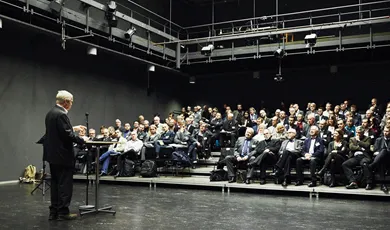Calls for Papers! Special Collection on International Military Interoperability in the Post-Ukraine War Era. Manuscript Deadline: September 15, 2024. Guest Editors: Andreas Hagedorn Krogh & Anders Klitmøller, Royal Danish Defence College. We invite papers for this Special Collection in Scandinavian Journal of Military Studies aiming to advance research on the new and pressing research agenda of international military interoperability. (https://sjms.nu/calls-for-papers)
 Photo: Joel Thungren, Swedish Armed Forces
Photo: Joel Thungren, Swedish Armed Forces
You can find more information here: https://sjms.nu/calls-for-papers
and a PDF here
Following Russia’s war on Ukraine and the new and complex hybrid threats emerging in its wake, NATO and the EU have intensified their focus on improving conditions for multilateral collaboration, cooperation and coordination to enhance the capacity for the collective defence of Europe. Aiming for closer integration with NATO and EU allies, Finland joined NATO in 2023, Denmark abolished their EU defence opt-out in 2022, while Sweden has applied for membership.
In both NATO and the EU, the notion of interoperability continues to serve as a defining concept for “the ability to operate in synergy in the execution of assigned tasks” (Derleth, 2015) and, more broadly speaking, “the ability for Allies to act together coherently, effectively and efficiently to achieve tactical, operational and strategic objectives” (NATO, 2023). Ideally, interoperability reduces duplication, enables pooling of resources, and produces synergies in military force generation and deployment. Aiming to serve as a force multiplier and a streamliner of national efforts, interoperability relies on the standardisation, harmonisation and integration of military doctrines and command structures; the development of common terminology, training, and exercises; as well as coordinated procurement of equipment, technology, and weapon systems.
Mirroring the increasing focus on interoperability in practice, a substantial body of grey literature has focused on interoperability as well as the international military governance of the joint development and deployment of armed forces (see for example Fellinger, 2013; Pernin et al., 2020; Hill et al. 2021). Yet, scientific research on the topic is still scarce (for notable exceptions, see Moon et al. 2008; Diallo and Padilla, 2012; Danielsson, 2022). The current developments warrant conceptual and empirical examinations of the conditions, processes and effects of contemporary attempts at enhancing international military interoperability with the prospective of advancing both research and practice.
At this critical moment in time, this Special Collection aims to fill this gap. We invite both conceptual and empirical contributions from a wide range of scientific disciplines and perspectives, including public policy, governance, management, administration, organization, leadership, and command. Empirical cases may include the Scandinavian countries, but this is not a requirement. Relevant topics of interests include, but are not limited to:
Supranational coordination and cooperation between NATO, the EU, and other international governance institutions regulating military force generation and deployment, and its effects on military interoperability between Allies, member states, and partner countries.
The assumptions and effects of NATO’s Connected Forces Initiative for improving interoperability through expanded education and training, increased exercises, and better use of technology.
The role and effects of international efforts to harmonize national defence and security strategies, for example NATO’s seven baseline requirements for civil preparedness, the EU’s Critical Entities Resilience Directive, or NATO’s Comprehensive Cyber Defense Policy.
The development in international command concepts and doctrines, for example Mission Command and Collective Command, their impact upon national command practices, and their implications for interoperability between allied armed forces.
The international attempts at improving interoperability through public-private partnerships with the defence industry, commercial technology companies, private logistics providers, etc.
Submission deadline
To submit a paper to the special collection, upload a full article manuscript at sjms.nu at the latest September 15, 2024. See Author guidelines here.
For submission inquires, contact journal manager of SJMS, Ragnild Lome at ralo@fak.dk.
Guest editor Andreas Hagedorn Krogh can be contacted directly at ankr@fak.dk.
Articles to be published in spring/summer 2025.
References
Danielsson, A. (2022). Producing the military urban(s): Interoperability, space-making, and epistemic distinctions between military services in urban operations. Political Geography, 97, 102649.
Derleth, J. (2015). Enhancing interoperability: the foundation for effective NATO operations. NATO Review. Available at: https://www.nato.int/docu/review/articles/2015/06/16/enhancing-interoperability-the-foundation-for-effective-nato-operations/index.html.
Diallo, S., and Padilla, J. (2012). Military interoperability challenges. In J. A. Sokolowski and C. M. Banks (Eds), Handbook of Real‐World Applications in Modeling and Simulation, Hoboken, NJ: Willey, pp. 298-327.
Fellinger, P. W. (2013). Enhancing NATO Interoperability. Philadelphia, PA: United States Army War College.
Hill, R., Hawco, D., Routh, A., Mariani, J., and Keyal, A. (2023). Sum of its parts: Military interoperability and the future of warfare. Deloitte Center for Government Insights.
Moon, T., Fewell, S., and Reynolds, H. (2008). The What, Why, When and How of Interoperability. Defense & Security Analysis, 24(1), 5–17.
NATO (2023). Interoperability: connecting forces. Available at: https://www.nato.int/cps/en/natohq/topics_84112.htm.
Pernin, C. G., O’Mahony, A., Germanovich, G., and Lane, M. (2020). Chasing Multinational Interoperability. Santa Monica, CA: RAND Corporation.
 Photo: Antonia Sehlstedt, Swedish Armed Forces
Photo: Antonia Sehlstedt, Swedish Armed Forces














